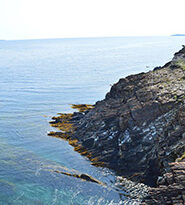NCC: Land Lines – A bittersweet farewell
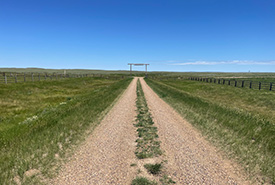
Kylie’s last time leaving OMB, SK (Photo by NCC)
I started with the Nature Conservancy of Canada (NCC) in 2014 as an intern for southwest Saskatchewan. Fresh out of college, I had never been to this part of the province, and quickly realized that it indeed is a different world down there. Roads are few and far between, rarely paved and often not even gravelled, and you can walk for kilometres without crossing a fence. This is a big contrast to the agricultural world that I grew up in only four or five hours north, where almost every quarter section of land is fenced and there is a road every kilometre and a half.
For the next few years, I really jumped into my job with both feet, travelling all over the province with my colleagues. Northern Saskatchewan is so beautiful with all the trees and abundance of wildlife. I also spent a lot of time down at NCC’s Old Man on His Back Prairie and Heritage Conservation Area (OMB) in southwest Saskatchewan, or often referred to within our office as “the ranch.” With a small house attached to the interpretive centre, staff often stay at OMB when working on other properties in the area. OMB is typically buzzing with visitors, researchers or people in the area tending to the cattle or bison that live there.
I eventually returned to the southwest more permanently to cover a maternity leave position for a natural areas manager for southwest Saskatchewan. I often would be by myself down at OMB, and it was during this time I started to really get to know the people in the area and the patrons of the ranch. Getting invited for suppers, to branding or to check cows by horseback really made OMB turn more into a second home for me. Waking up to an OMB sunrise, having a coffee on the front porch, and often seeing a family of red fox playing, or hearing the bison grunting to each other if they were close enough to the yard — it really is as peaceful out there as I am describing. Life slows down when you are there.
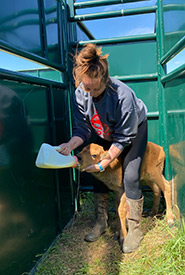
Kylie feeding Sunny the bison calf at OMB, SK (Photo by NCC)
One of the highlights of OMB is seeing the bison herd, and for staff, working with them at the bison roundup every winter. The round-up consists of herding the animals into the corral system, tagging with an RFID tag, weaning calves and any yearlings, checking animals overall health, and removing animals from the herd as necessary.
After covering for the maternity leave position in the southwest, I took on a manager role for the Missouri Coteau Natural Area. This area kept me busy, as it encompasses nearly 120 conservation agreement properties, and 19 fee simple (owned outright by NCC) properties and complexes. It was new and exciting, with properties stretching from the Lake Diefenbaker area, down to the US border near Minton, SK. But, with so many properties, I never became as familiar or attached to any as I was with OMB. The ranch really had created a special place for itself in my heart. Over time, I bounced in and out of various projects with the ranch, along side my regular Missouri Coteau role. The added workload was only welcomed because it was OMB and gave me an excuse to be out there on the landscape, with the bison and the patrons again.
Some of the highlights of my career include attending the international bison conference in Montana, attending the first Indigenous Advisory Group weekend at OMB, learning about and participating in traditional bison harvests, and meeting so many farmers and ranchers across the province. I experienced a connection to the land in a different way than I did before my time with NCC, and feel fortunate to have met so many good people and great stewards of the land. I truly have too many good memories to count after eight years with NCC.
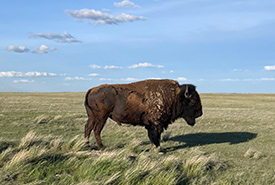
An old bison bull (Photo by NCC)
Overall, my favourite task has been managing the bison herd at OMB. I committed to taking care of them as if they were my own animals; advocating for their well-being, watching the herd grow in calves and replacement heifers, selecting new bulls and making hard decisions when necessary. As stressful as the bison roundups can be (especially on the people organizing it), opening the gates to the winter pasture after each annual bison roundup was a bittersweet feeling. I would silently hope that nature would take it easy on the older cows and the young calves, and that everyone would have a good winter. The bison typically graze in their winter pasture, as they would in the wild, but are monitored in case they need supplemental feed due to extreme weather. Saskatchewan is no stranger to extreme winter weather, which was always the cause for my concern.
I had a healer once tell me that she envisioned me in a previous lifetime, standing on a hill, surrounded by the wide-open prairie, overlooking a herd of bison. I’m not going to try and make you a believer in mediums and healers, as I was always a skeptic. But, it’s pretty incredible to think that a scene set hundreds of years ago is not so far off from my work life in this lifetime.
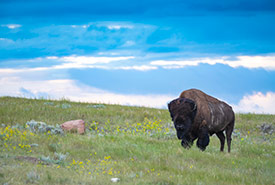
Bison at Old Man on His Back Prairie and Heritage Conservation Area (Photo by Jason Bantle)
Managing OMB has been one of the biggest honours, the most challenging and rewarding experiences of my life. It makes it very difficult and emotional to finally take a step back and make the decision not to return after my upcoming maternity leave. As I drove away from OMB for the last time as an NCC employee, I definitely had a lump in my throat. I know it will be in good hands, and that the bison will be cared for. I know I will be back to OMB, but next time as a guest and not as a self-appointed host. Change is hard, but I am excited to see what the future has in store for me, my little farm and hopefully, soon, our own bison herd.



